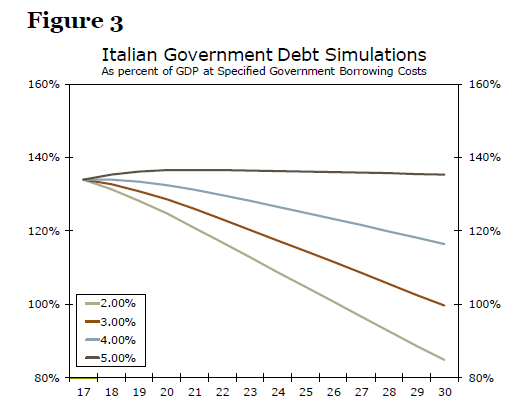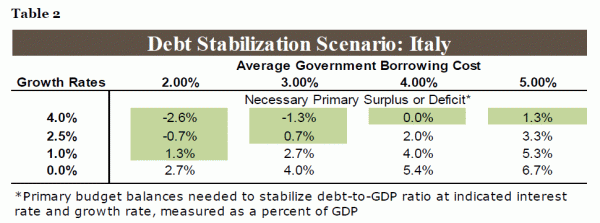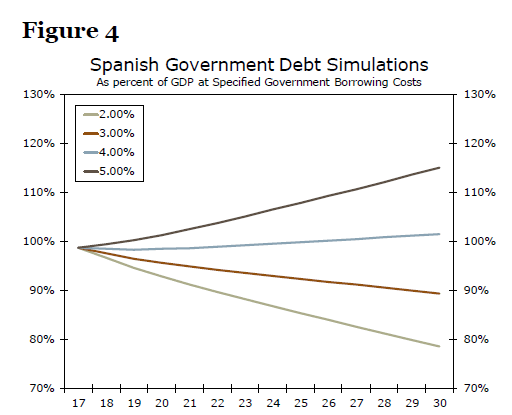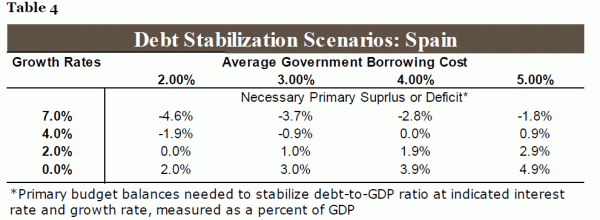Executive Summary
After three years of relative calm, volatility has returned to sovereign bond markets in the euro area due to political uncertainty in Italy and, to a lesser extent, Spain. The Italian government has been able to stabilize its debt-to-GDP ratio in recent years due to sizeable fiscal surpluses, but it is uncertain whether that austerity will continue. Renewed fiscal largesse could lead to a vicious circle of increasing fiscal deficits, higher borrowing costs, slowing economic growth, even larger deficits, etc. The probability of such a vicious circle developing seems to be lower in Spain than in Italy. In our view, it is too early to make confident predictions about how the situation in Italy will ultimately evolve. Much will depend on political decisions that are made in coming months, not only in Italy but in other European countries as well. Readers should be prepared for more volatility in coming months as domestic and foreign actors in the Italian saga make their decisions.
European Bond Markets in Turmoil Again Due to Political Uncertainty
Sovereign debt markets in the euro area, which have been more or less stable since the last Greek government debt crisis in 2015, have encountered turbulence again in the past week or so. The catalyst this time has been political uncertainty in Italy and, to a lesser extent, Spain. The yield on the 10-year government bond in Italy has jumped by more than 100 bps over the past two weeks, while the yield on the comparable bond in Spain is up about 25 bps or so over that period (Figure 1). The euro has also weakened over the U.S. dollar (Figure 2).
In Italy, political uncertainty has been building since the inconclusive general election on March 4 in which no party won enough seats in the Italian parliament to govern solely. But on May 18, the Five Star Movement (5SM), a populist party that tends to have some left-wing views, and the Lega Nord (LN), another populist party that is on the right of the political spectrum, announced that they had reached agreement to form a coalition government. The parties chose Giuseppe Conte, a law professor with little political experience, as their nominee for prime minister, and they named Paolo Savona, an 81-year old economist who previously has called for Italy to exit the Eurozone, as finance minister. This combination proved to be too much for President Mattarella to stomach. He refused to approve the proposed government, which he is constitutionally permitted to do, and it quickly fell apart. It is apparently the intention of President Mattarella to now name a caretaker government, and Italians likely will head back to the polls this autumn for another election.
In Spain, the government of Prime Minister Rajoy, who has governed Spain since 2011, faces a possible no-confidence vote in the Spanish parliament due to corruption allegations. If the government loses the confidence vote, then voters in Spain likely would be heading to the polls as well.
How Much Fiscal Flexibility Does Italy Have?
Although bond yields in Italy and Spain at present are nowhere near the highs that they reached during the first sovereign debt crisis in 2011-2012, it may be a useful exercise to consider how debt dynamics in each country may be affected if borrowing costs remain at current levels or even climb higher. Let’s start with Italy first. As we have written in previous reports, a country’s debt-to-GDP ratio is affected by its primary budget balance, nominal GDP growth rate and borrowing costs. There obviously are infinite combinations of these three variables, but we focus on four potential scenarios for the Italian debt-to-GDP ratio in Figure 3. For each scenario we use IMF forecasts for nominal GDP growth and the primary budget balance (Table 1), and then consider four different potential borrowing costs.
The debt-to-GDP ratio of the Italian government at the end of 2017 was roughly 134 percent. Before bond yields started their rapid ascent a few weeks ago, the Italian government was issuing longerdated bonds with coupons of approximately 2 percent. If volatility subsides and the Italian government can issue bonds with coupons of roughly 2 percent, then the debt-to-GDP ratio would recede markedly between now and 2030 as long as nominal GDP growth and the primary budget surplus evolve in line with the IMF forecasts. Even if coupons on newly issued Italian government bonds should rise to 5 percent, where they were at the height of the 2011-2012 European sovereign debt crisis, Italy should be able to stabilize its debt-to-GDP ratio.
But this sanguine outcome depends on two optimistic assumptions. First, Italy can maintain a nominal GDP growth rate in excess of 2 percent per annum. Nominal GDP in Italy grew 2.1 percent in 2017, but this solid performance has been rare in recent years. Specifically, nominal GDP in Italy has grown at an annual average growth rate of only 1.1 percent since the end of the global financial crisis in 2010. The second optimistic assumption is that the primary budget surplus will rise from roughly 2 percent this year to 3.6 percent in 2022. Although the Italian government has generally incurred black ink in its primary budget balance since the early 1990s, a budget surplus of this magnitude implies that fiscal policy is quite austere. This latest bout of financial market volatility started when the two potential coalition partners announced that they would aim to enact a flat tax as well as a guaranteed minimum income, stoking concerns that the budget balance would deteriorate sharply. Therefore, it seems that some sensitivity analysis around these favorable debt projections is in order.
Table 2 shows combinations of nominal GDP growth and borrowing costs that would be needed to stabilize Italy’s debt-to-GDP ratio at 134 percent for given primary budget balances. For example, if the Italian government wants to run a primary deficit equal to 2.6 percent of GDP (the upper left cell in Table 2), then nominal GDP growth would need to equal 4 percent per annum and borrowing costs would need to be only 2 percent for the debt-to-GDP ratio to remain stable. In our view, it is not likely that Italy would be able to realize this favorable combination of nominal GDP growth rate and borrowing cost anytime soon.
Given its lackluster GDP growth rate, Italy does not appear to have much space to ease fiscal policy significantly. Last year, the government ran a fiscal surplus equivalent to 1.7 percent of GDP. If it wants to ease fiscal policy relative to last year (indicated by the light green boxes in Table 2), then the economy would need to grow markedly faster and/or borrowing costs would need to remain quite low. A move toward significant fiscal easing could lead to a vicious circle of rising bond yields, slower growth, even higher deficits, etc. Indeed, the political uncertainty that now exists in Italy may have jumpstarted such a vicious circle.
Spain: Debt Is Sustainable as Long as the Economy Continues to Grow
As noted above, government bond yields in Spain have risen recently, although not to the same extent as in Italy. Looking forward, the IMF projects that nominal GDP growth in Spain will downshift somewhat over the next few years and that the primary budget balance will swing from a modest deficit of 0.8 percent of GDP in 2017 to small surpluses in coming years (Table 3). Under these assumptions, coupons on newly issued Spanish government bonds could rise to 4 percent – the average coupon on outstanding government bonds is roughly 3 percent at present – without leading to a marked rise in the government’s debt-to-GDP ratio (Figure 4).
The Spanish economy has grown roughly 4 percent per annum in nominal terms since 2015 due, at least in part, to labor market reforms that have helped Spain restore price competitiveness vis-àvis other countries. As long as the country can maintain a reasonably solid nominal GDP growth rate, the government should be able to able to stabilize, if not reduce, its debt-to-GDP ratio without an undue amount of fiscal tightening (Table 4). In our view, there is a lower probability of a vicious circle developing in Spain than in Italy.
Is It ‘Different’ This Time?
Yields on Italian, Portuguese and Spanish government bonds moved significantly higher during the first European sovereign debt crisis in 2011-2012 because there were no financial backstops in place at that time to shore up countries in need of financial assistance. But the European Stability Mechanism (ESM), a €500 billion fund that can be tapped to assist ailing countries, is now capitalized and operational. Furthermore, the European Central Bank has credibly done “whatever it takes to preserve the euro.”2 The combined firepower of the ESM and the ECB makes a collapse of the Eurozone less likely today than it was in 2011-2012. But, Italy is among the 10 largest economies in the world, and its government debt outstanding totals €2.3 trillion. A financial fire in Italy, should one start, may be difficult to extinguish.
Conclusion
Sovereign bond markets in Europe generally have been quiet since the last Greek debt crisis in the summer of 2015. However, volatility has returned to “peripheral” bond markets (Italy, Spain, Portugal and Greece) in recent days due to political uncertainty in Italy and, to a lesser extent, Spain. Although volatility could conceivably subside somewhat in coming days, a decline in yields to the levels that existed a few weeks ago in these markets does not seem likely in the near term. Italians probably will be heading back to the polls this autumn, and political uncertainty in Italy likely will remain elevated until the next general election and perhaps beyond. Elevated levels of political uncertainty could spread to Spain, too, if Prime Minister Rajoy does not survive a confidence vote.
Italy has been able to stabilize its government debt-to-GDP ratio over the past few years due to sizeable surpluses in its primary budget balance. However, it will be difficult for the Italian government to bring about a meaningful reduction in its debt-to-GDP ratio in the absence of continued fiscal austerity due to the country’s inherently weak economic growth rate. But, it was frustration with the malaise in the economy, which is due in part to chronic austerity that led Italians in the March 4 elections to vote for populist parties that reject austerity.
In our view, it is too early to make confident predictions about how the situation in Italy will ultimately evolve. Much will depend on political decisions that are made in coming months. President Mattarella will probably ask Italian citizens to make political decisions by returning to the polls in a few months for a new round of elections. The outcome of those elections will eventually produce a government that will make its own decisions regarding fiscal policy, and those decisions could help to stabilize the situation or lead to further financial instability. And decisions that are made by political leaders in other European countries and by authorities at the ESM and the ECB will also play a role in the ultimate outcome of the current situation in Italy. To repeat, it is too early to make confident predictions about how the situation in Italy will ultimately evolve, but readers should be prepared for more volatility in the coming months as the actors in the Italian saga make their decisions.





















